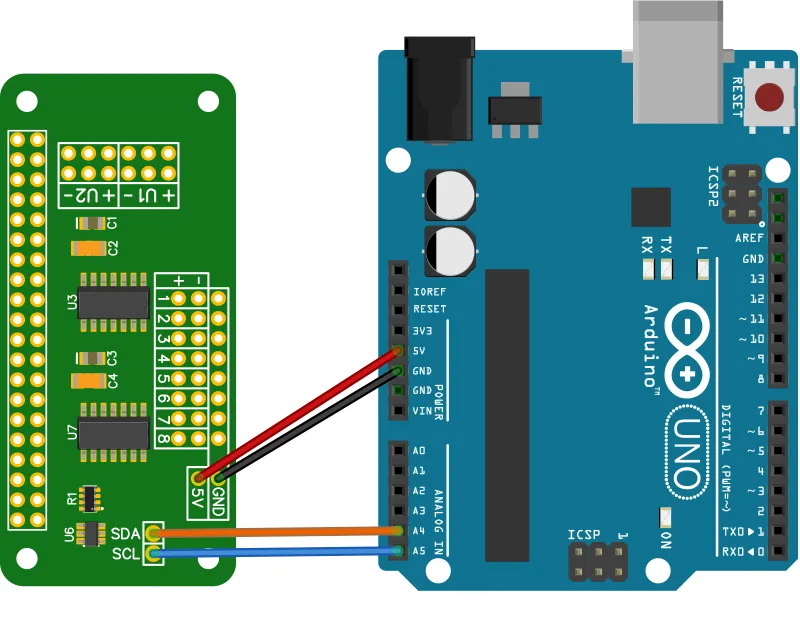The AB Electronics UK Knowledge Base provides support solutions, tutorials and troubleshooting guides.

- Home
- Help and Support
- Knowledge Base
- ADC Pi Tutorials
- Using the ADC Pi with Arduino
-
Raspberry Pi
- PCB Header Assembly Jig
- Raspberry Pi GPIO Pins
- Samba Setup on Raspberry Pi
- Set a static IP Address on Raspberry Pi OS Bookworm
- I2C Part 1 - Introducing I2C
- I2C Part 2 - Enabling I2C on the Raspberry Pi
- I2C Part 3 - I2C tools in Linux
- I2C Part 4 - Programming I2C with Python
- SPI and Python on Raspberry Pi OS
- Using Pythonpath with our Python Libraries
- Connecting Development Boards to the Raspberry Pi 400
- General
- Code & Languages
- Raspberry Pi Pico Tutorials
- 1 Wire Pi Tutorials
- ADC Pi Tutorials
- ADC DAC Pi Zero Tutorials
- ADC Differential Pi Tutorials
- Expander Pi Tutorials
-
IO Pi Plus Tutorials
- IO Pi Plus FAQ
- IO Pi Plus Tutorial 1 - The Blinking LED
- IO Pi Plus Tutorial 2 - Push the Button
- IO Pi Plus Tutorial 3 - Introducing Interrupts
- IO Pi Plus Tutorial 4 - More Interrupts
- IO Pi Plus Tutorial - MQTT Reading the Ports
- IO Pi Plus with Raspberry Pi Pico
- IO Pi Plus Tutorial - MQTT Control
- Driving Relays or Higher Loads with the IO Pi Plus
- 16 Channel Opto-Isolated Input Board
- Relay Board for the IO Pi Plus 2.1
- IO Zero 32 Tutorials
- RTC Pi Tutorials
- Serial Pi
- Servo PWM Pi Tutorials
-
Home Assistant
- Using 1 Wire with Home Assistant and the Raspberry Pi OS
- Using I2C Devices on the Raspberry Pi with Home Assistant
- Using the ADC Differential Pi with Home Assistant on the Raspberry Pi
- Using the ADC Pi with Home Assistant on the Raspberry Pi
- Using the IO Pi Plus with Home Assistant on the Raspberry Pi
-
Legacy Products
- ADC DAC Pi (Discontinued)
- ADC Pi (Discontinued)
- Buffer Pi - Legacy Product
- Com Pi (Discontinued)
- Delta-Sigma Pi (Discontinued)
- Expander Pi (Discontinued)
- IO Pi (Discontinued)
- IO Pi Plus 1.0 (Discontinued)
- IO Pi Zero (Discontinued)
- Logic Level Converter (Discontinued)
- RTC Alarm Pi (Discontinued)
- RTC Pi (Discontinued)
- Serial Pi (Discontinued)
- 1 Wire Pi (Discontinued)
- 1 Wire Pi Plus 1.0 (Discontinued)
- Other Supported Platforms
Using the ADC Pi with Arduino
Using the ADC Pi with the Arduino range
The ADC Pi can also be used with the Arduino range of development boards or any other processor with an I2C interface.
The Arduino library for MCP3424 from ArduSat allows you to easily use the 8 different analogue inputs on the ADC Pi with your Arduino project and stack up to 4 ADC Pi boards, giving you up to 32 x 18-bit ADC inputs.
You can download the library and sample code from our GitHub repository
The image below shows how you can connect your ADC Pi to your Arduino UNO using only 4 wires.

Address Table for ADC Pi inputs
| Pin 1 | Pin 2 | ADC Address |
|---|---|---|
|
Low or Float |
Low or Float |
0x68 |
|
Low |
Float |
0x69 |
|
Low |
High |
0x6A |
|
Float |
Low |
0x6B |
|
High |
Low |
0x6C |
|
High |
Float |
0x6D |
|
High |
High |
0x6E |
|
Float |
High |
0x6F |
(images created with Fritzing)
